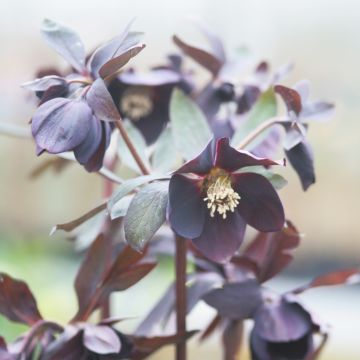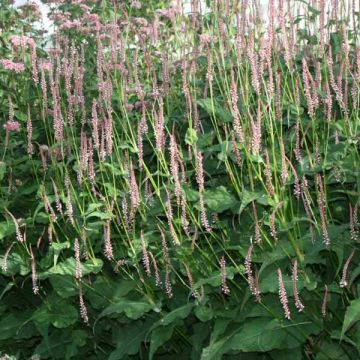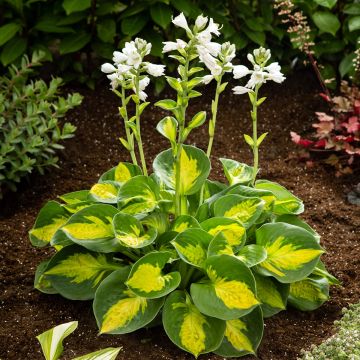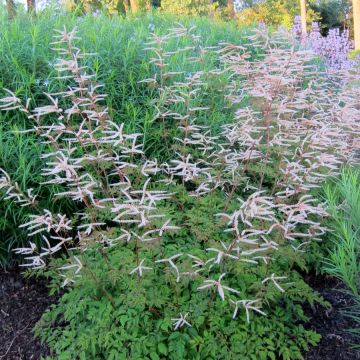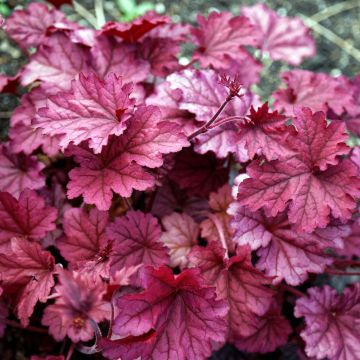

Hellébore ViV® Patrizia - Helleborus orientalis


Hellébore ViV® Patrizia - Helleborus orientalis
Helleborus hybridus ViV Patrizia
Helleborus x hybridus ViV® Patrizia
Lenten Rose, Oriental Hellebore
This item cannot be shipped to the selected country
Delivery charge from €5.90
More information
Schedule delivery date,
and select date in basket
This plant carries a 12 months recovery warranty
More information
We guarantee the quality of our plants for a full growing cycle, and will replace at our expense any plant that fails to recover under normal climatic and planting conditions.
From €5.90 for pickup delivery and €6.90 for home delivery
Express home delivery from €8.90.
Does this plant fit my garden?
Set up your Plantfit profile →
Description
Helleborus x hybridus ViV Patrizia is a very recent variety that stands out for the beautiful reddish colour of its flowers. Blooming for several weeks from September , this Lenten Rose produces simple, well-coloured flowers that are visible against the dark green foliage. These sculptural, cut evergreen leaves are decorative all year round. It is a robust and hardy perennial, easy to grow in all regions, even slightly heavy soil, although it prefers humus-rich soil. It needs to be protected from strong sunlight and can thrive in marked shade.
The ViV® Hellebores are varieties resulting from in-vitro multiplication. Unlike varieties resulting from seed sowing, Hellebores produced by in-vitro guarantee a flowering that is rigorously identical to the variety they come from. They have the same genetic characteristics as the mother plant, are more vigorous, and develop in a uniform manner.
Hellebore Patrizia belongs to the Ranunculaceae family, which includes about sixty genera and around 2,500 species, most of which are poisonous. The species Helleborus orientalis is native to Greece, Turkey, and the centre and east of the Caucasus. It is a perennial plant that hybridizes very easily with other species, resulting in randomly sown hybrids with many varied colours and forms. These hybrids are rarely given variety names; they are distinguished by shape and colour. Oriental Hellebore is a hardy plant that can withstand temperatures as low as -15°C, naturally growing in forests, thickets, and clearings up to 2,000 m (7ft) altitude.
This variety forms a tuft 35 to 45 cm (14 to 18in) tall with an equivalent width consisting of palmate, slightly toothed, dark and shiny green evergreen basal leaves which live for 8 months and are regularly replaced by new leaves.
Patrizia starts blooming from September and continues for long weeks, until October. Its simple flowers are made up of 5 delicately wavy petals, giving it a rather romantic appearance. The deep red corollas are extremely decorative and highlighted by the foliage. As with most varieties, they are arranged in a vertical plane, or even slightly inclined downwards, allowing water to slide off like an umbrella, avoiding accumulation in the centre that could cause rotting. Hellebore does not like to be moved once established, with young plants sometimes taking time to flower, so choose their location well.
With its well-coloured flowers, this Hellebore will be the star of autumn. It will enliven a semi-shaded bed where you can associate it with Aster divaricatus, which is also well adapted to shaded situations. Its small star-shaped white flowers will harmonize pleasantly with the deep red of Patrizia. If you like strong contrasts, plant Salvia Uliginosa African Skies in the background, a fairly tall Sage, about 1.50 m (5ft), with spikes of an incredible azure blue. Pretty Campanula glomerata Joan Elliot with violet flowers, blooms at the same time but is better separated from Patrizia by white flowers or variegated foliage, such as Hosta Minuteman to avoid any clash of tastes...
Report an error about the product description
Flowering
Foliage
Plant habit
Safety measures
Botanical data
Helleborus
x hybridus
ViV® Patrizia
Ranunculaceae
Lenten Rose, Oriental Hellebore
Cultivar or hybrid
ingestion
Cette plante est toxique si elle est ingérée volontairement ou involontairement.
Ne la plantez pas là où de jeunes enfants peuvent évoluer, et lavez-vous les mains après l'avoir manipulée.
Pensez à conserver l'étiquette de la plante, à la photographier ou à noter son nom, afin de faciliter le travail des professionnels de santé.
Davantage d'informations sur https://plantes-risque.info
Other Oriental Hellebore
Planting and care
Helleborus x hybridus Patrizia grows in any neutral to moderately chalky soil, even slightly acidic, rich, light or clayey, in partial or light shade, sheltered from cold and prevailing winds. Avoid direct sunlight during the hottest hours in the south. Plant from early autumn to spring. It thrives in deeply cultivated soil mixed with organic matter. To feed, use bone meal or another organic fertilizer. Water well after planting and add a layer of mulch 2 to 5 cm (1 to 2in) thick. Regularly remove faded leaves to improve flowering. Ensure a planting distance of 30 to 40 cm (12 to 16in) between each plant to promote their development. Hellebore does not tolerate stagnant water as it may cause rotting.
The roots should not dry out completely in summer. Hellebores can be affected by a fungal disease transmitted by aphids, called black spot. Remove any stained leaves when the flower buds appear. Remove faded flowers after seeding. They can also suffer from grey rot or die from collar rot due to poor growing conditions, in excessively wet situations.
On a balcony or terrace, plant this perennial in a pot 4 to 5 times larger than itself, as it needs space to develop its root system. This Hellebore can withstand temperatures down to -15°C (5°F), or even lower, allowing it to adapt to almost all regions.
Planting period
Intended location
Care
-
, onOrder confirmed
Reply from on Promesse de fleurs
Shade-loving perennials
Haven't found what you were looking for?
Hardiness is the lowest winter temperature a plant can endure without suffering serious damage or even dying. However, hardiness is affected by location (a sheltered area, such as a patio), protection (winter cover) and soil type (hardiness is improved by well-drained soil).

Photo Sharing Terms & Conditions
In order to encourage gardeners to interact and share their experiences, Promesse de fleurs offers various media enabling content to be uploaded onto its Site - in particular via the ‘Photo sharing’ module.
The User agrees to refrain from:
- Posting any content that is illegal, prejudicial, insulting, racist, inciteful to hatred, revisionist, contrary to public decency, that infringes on privacy or on the privacy rights of third parties, in particular the publicity rights of persons and goods, intellectual property rights, or the right to privacy.
- Submitting content on behalf of a third party;
- Impersonate the identity of a third party and/or publish any personal information about a third party;
In general, the User undertakes to refrain from any unethical behaviour.
All Content (in particular text, comments, files, images, photos, videos, creative works, etc.), which may be subject to property or intellectual property rights, image or other private rights, shall remain the property of the User, subject to the limited rights granted by the terms of the licence granted by Promesse de fleurs as stated below. Users are at liberty to publish or not to publish such Content on the Site, notably via the ‘Photo Sharing’ facility, and accept that this Content shall be made public and freely accessible, notably on the Internet.
Users further acknowledge, undertake to have ,and guarantee that they hold all necessary rights and permissions to publish such material on the Site, in particular with regard to the legislation in force pertaining to any privacy, property, intellectual property, image, or contractual rights, or rights of any other nature. By publishing such Content on the Site, Users acknowledge accepting full liability as publishers of the Content within the meaning of the law, and grant Promesse de fleurs, free of charge, an inclusive, worldwide licence for the said Content for the entire duration of its publication, including all reproduction, representation, up/downloading, displaying, performing, transmission, and storage rights.
Users also grant permission for their name to be linked to the Content and accept that this link may not always be made available.
By engaging in posting material, Users consent to their Content becoming automatically accessible on the Internet, in particular on other sites and/or blogs and/or web pages of the Promesse de fleurs site, including in particular social pages and the Promesse de fleurs catalogue.
Users may secure the removal of entrusted content free of charge by issuing a simple request via our contact form.
The flowering period indicated on our website applies to countries and regions located in USDA zone 8 (France, the United Kingdom, Ireland, the Netherlands, etc.)
It will vary according to where you live:
- In zones 9 to 10 (Italy, Spain, Greece, etc.), flowering will occur about 2 to 4 weeks earlier.
- In zones 6 to 7 (Germany, Poland, Slovenia, and lower mountainous regions), flowering will be delayed by 2 to 3 weeks.
- In zone 5 (Central Europe, Scandinavia), blooming will be delayed by 3 to 5 weeks.
In temperate climates, pruning of spring-flowering shrubs (forsythia, spireas, etc.) should be done just after flowering.
Pruning of summer-flowering shrubs (Indian Lilac, Perovskia, etc.) can be done in winter or spring.
In cold regions as well as with frost-sensitive plants, avoid pruning too early when severe frosts may still occur.
The planting period indicated on our website applies to countries and regions located in USDA zone 8 (France, United Kingdom, Ireland, Netherlands).
It will vary according to where you live:
- In Mediterranean zones (Marseille, Madrid, Milan, etc.), autumn and winter are the best planting periods.
- In continental zones (Strasbourg, Munich, Vienna, etc.), delay planting by 2 to 3 weeks in spring and bring it forward by 2 to 4 weeks in autumn.
- In mountainous regions (the Alps, Pyrenees, Carpathians, etc.), it is best to plant in late spring (May-June) or late summer (August-September).
The harvesting period indicated on our website applies to countries and regions in USDA zone 8 (France, England, Ireland, the Netherlands).
In colder areas (Scandinavia, Poland, Austria...) fruit and vegetable harvests are likely to be delayed by 3-4 weeks.
In warmer areas (Italy, Spain, Greece, etc.), harvesting will probably take place earlier, depending on weather conditions.
The sowing periods indicated on our website apply to countries and regions within USDA Zone 8 (France, UK, Ireland, Netherlands).
In colder areas (Scandinavia, Poland, Austria...), delay any outdoor sowing by 3-4 weeks, or sow under glass.
In warmer climes (Italy, Spain, Greece, etc.), bring outdoor sowing forward by a few weeks.


































